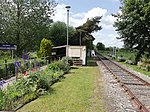Morley, Norfolk
Civil parishes in NorfolkNorfolk geography stubsSouth Norfolk

Morley is a civil parish in the South Norfolk district, in the county of Norfolk, England. It includes the villages of Morley St Botolph and Morley St Peter. It covers an area of 8.21 km2 (3.17 sq mi) and had a population of 973 in 182 households at the 2001 census, increasing to a population of 1.241 in 191 households at the 2011 census.
Excerpt from the Wikipedia article Morley, Norfolk (License: CC BY-SA 3.0, Authors, Images).Morley, Norfolk
High Common, South Norfolk Morley
Geographical coordinates (GPS) Address Nearby Places Show on map
Geographical coordinates (GPS)
| Latitude | Longitude |
|---|---|
| N 52.557 ° | E 1.06 ° |
Address
High Common
High Common
NR18 9BX South Norfolk, Morley
England, United Kingdom
Open on Google Maps









